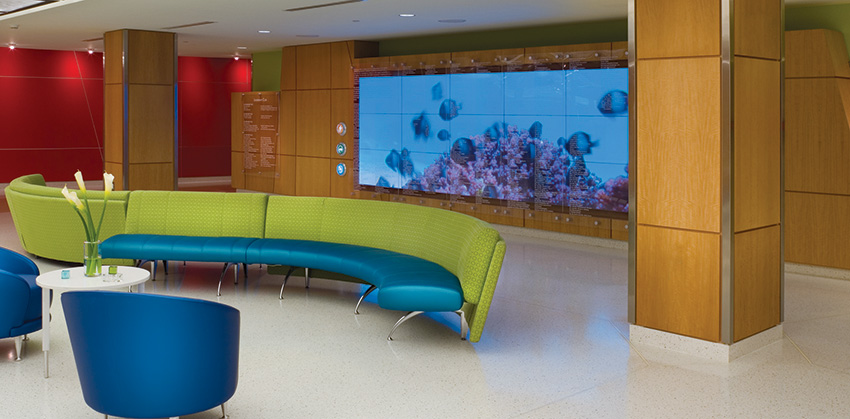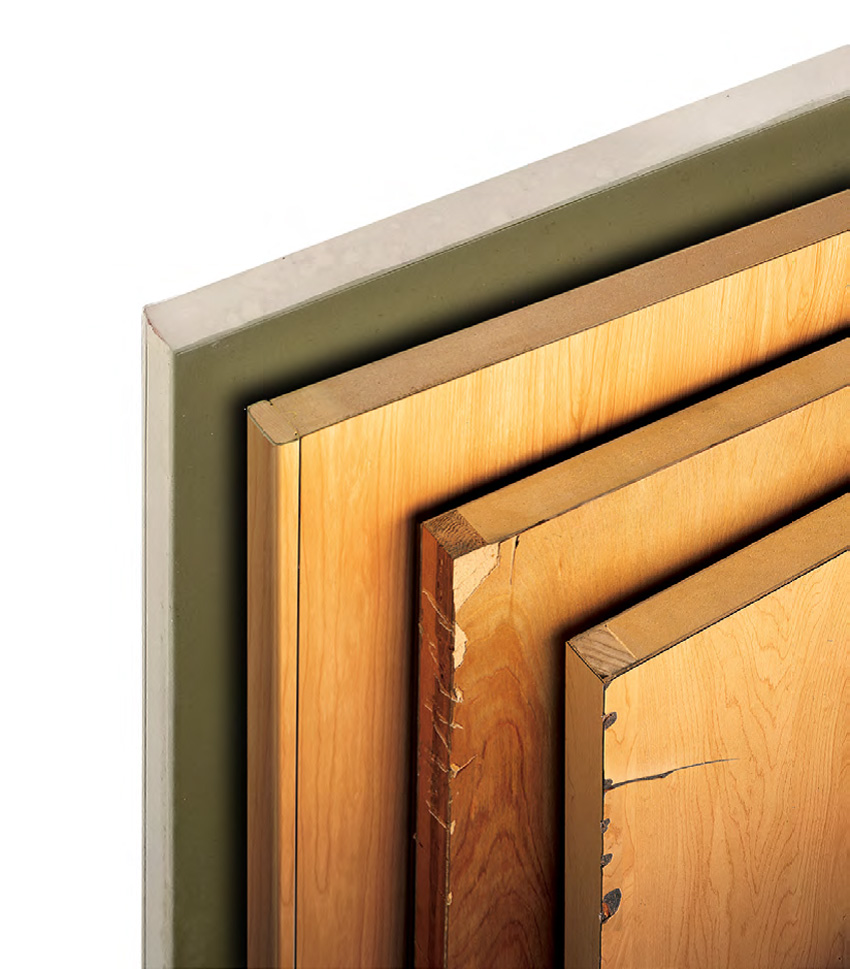Health Care: Better Designs for Better Care
Crash Rails and Corner Guards
Crash rails and corner guards are available in various materials, colors, and styles to help protect walls from damage. Depending on the material type, crash rails and corner guards have excellent shock-absorbing qualities and can save not only the physical integrity of walls and corners but also the aesthetic design seen by all who pass through the common areas.

Photo courtesy of Construction Specialties
Corner guards protect wall edges from damage in high-traffic areas.
Doors
Doors are another building feature that are regularly used in high-traffic areas. Depending on the building usage, different materials can be specified. The four main types of door materials are wood veneer, plastic laminate, hollow metal, and doors with a sturdy inner core that are clad in a protective material.
Wood veneer doors are made from a thin piece of wood treated either with or without a protective varnish. Wood veneer doors are often lightweight and specified because of their lower initial investment cost. When these doors become damaged, they can be repaired using putty that is cured onto the door. This repetitive fix is visible and not ideal for high-traffic areas.

Image courtesy of Construction Specialties
Wood veneer doors show damage, even after repairs are made.
Plastic laminate doors have a surface layer that is adhered to the door’s core. The core material is usually wood, particle, or composite materials. Like wood veneer doors, plastic laminate doors are suitable for low traffic. These doors have a low initial cost but are difficult and time consuming to repair.
Hollow metal doors are made from metal or aluminum and may feature a cardboard core. While these doors are suitable in areas with medium traffic, they often look like structures that belong in institutions, which do not provide an inviting aesthetic appeal. They also can be dented easily and must be repainted twice a year.
The ideal door solution is a door with a sturdy inner core that is clad in protective material. This protective material will prevent damage caused by foot traffic, the transport of patients, and the movement of heavy machinery and carts from place to place. While these products are often more expensive up front, long-term cost savings can recover initial costs because they do not need to be repaired as frequently.
Fire Protection
In case of fire, materials that are fire rated can prevent the spread of fire or increase the amount of time available for occupants to safely escape. ASTM E 84 tests are used by code officials and regulatory agencies in the acceptance of interior finish materials for various applications. The flame spread Index and Smoke Developed Index are dictated by ASTM E84.
Interior finish materials that can be used on ceilings, walls, and doors are classified in accordance with ASTM E-84. The International Fire Code (IFC) sets requirements for the classification of interior finish materials. They are grouped in three classes in accordance with their Flame Spread and Smoke Developed Indexes:
Class A or I: Flame Spread 0-25; Smoke Developed: 0-450
Class B or II: Flame Spread 26-75; Smoke Developed: 0-450
Class C or III: Flame Spread 76-200; Smoke Developed: 0-450
Walls and Wall Protection
Wall-protection materials are rated using the tunnel test dictated by ASTM E84. When selecting wall protection materials and products, look for products that allow less flame spread and also ones that develop less smoke. In large facilities that contain a large percentage of wall area, resistance to flame spread and smoke development can mean the difference between life and death for patients and occupants trying to escape or be rescued.
Doors
Fire-protection standards for doors are dictated by the National Fire Protection Association (NFPA). NFPA 80 provides standards for fire doors and other openings. When selecting materials for doors and specifying products, look for fire-rated doors that comply with clearance requirements and references to the quality standard for fitting in accordance with the requirements listed in NFPA 80. Some doors are fire rated up to 90 minutes, which can increase the time for firefighters or internal sprinklers to put out fires and occupants to safely vacate or be rescued.
Safety Protection for Specific Populations
Ligature-resistant brackets and handrails are typically used in behavioral health environments to provide an additional level of patient safety; however, today many facilities are focusing on making mental health accommodations available in all health-care facilities, not just those specific to behavioral health treatment.
Ligature-resistant products reduce patients’ ability to bind themselves to objects, which can help reduce the occurrence of self-inflicted harm. Ligature-resistant brackets made from continuous aluminum can be used on handrails. Cubicle curtains and tracks are also available in ligature-resistant designs, thus reducing the potential for self-harm through the use of these materials that are often in patient treatment areas. Ligature resistance is also considered in door-handle design in specific applications.
In health-care facilities, patient falls are a common danger and concern. One way to reduce the risk of falls is to provide handrail support in common areas as well as in restrooms, showers, and in patient rooms between traffic areas, such as from the bed to the bathroom.
Bariatric handrails are stronger and more resilient than typical handrails. They can accommodate up to 1,000 pounds when installed per the manufacturer’s guidelines. Guidelines for handrails can be found in the 2010 FGI Guidelines for Design and Construction of Health-Care Facilities. Products that meet or exceed these guidelines are ideal for use in health-care settings, especially when accommodating specific patient needs.
Notice

CertainTeed.com/TargetedAcoustics

www.c-sgroup.com/cubicle-curtains-and-tracks/snap-lock-cubicle-curtains










